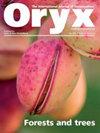制定一个框架以改进全球保护区覆盖范围的估计
IF 2.1
3区 环境科学与生态学
Q2 BIODIVERSITY CONSERVATION
引用次数: 0
摘要
基于区域的生物多样性保护是一种广泛使用的生物多样性保护方法,全球范围内合适的生物多样性保护区域覆盖目标一直是人们讨论的焦点。为了为这些争论提供信息,有必要了解当前保护区网络的范围和生态代表性,但这受到现有全球数据集差距的阻碍。特别是,虽然在国家一级经常可以获得关于私人和社区管理的保护区以及其他有效的基于区域的保护措施的数据,但将这些数据纳入官方数据集可能需要许多年的时间。这表明需要一种补充性的方法,基于选择国家样本并利用其国家规模的数据集来产生更准确的衡量标准。然而,每增加一个国家的样本,就会增加数据收集、整理和分析的成本。为了解决这个问题,本文提出了一个以空间优先排序算法为基础的数据收集框架,该框架确定了一组最小的国家,这些国家也代表了影响保护区建立和生物多样性模式的10个因素。然后,我们通过确定一组代表性的采样单元来说明这种方法,这些采样单元覆盖了10%的陆地领域,其中仅包括25个国家的地区。相比之下,随机选择10%的陆地面积,包括平均162个国家的地区。这些采样单位可以成为未来不同类型保护区数据整理的重点。分析这些数据可以对全球保护区的覆盖范围和生态代表性作出更迅速和准确的估计,从而补充现有的国际报告系统。本文章由计算机程序翻译,如有差异,请以英文原文为准。
Developing a framework to improve global estimates of conservation area coverage
Abstract Area-based conservation is a widely used approach for maintaining biodiversity, and there are ongoing discussions over what is an appropriate global conservation area coverage target. To inform such debates, it is necessary to know the extent and ecological representativeness of the current conservation area network, but this is hampered by gaps in existing global datasets. In particular, although data on privately and community-governed protected areas and other effective area-based conservation measures are often available at the national level, it can take many years to incorporate these into official datasets. This suggests a complementary approach is needed based on selecting a sample of countries and using their national-scale datasets to produce more accurate metrics. However, every country added to the sample increases the costs of data collection, collation and analysis. To address this, here we present a data collection framework underpinned by a spatial prioritization algorithm, which identifies a minimum set of countries that are also representative of 10 factors that influence conservation area establishment and biodiversity patterns. We then illustrate this approach by identifying a representative set of sampling units that cover 10% of the terrestrial realm, which included areas in only 25 countries. In contrast, selecting 10% of the terrestrial realm at random included areas across a mean of 162 countries. These sampling units could be the focus of future data collation on different types of conservation area. Analysing these data could produce more rapid and accurate estimates of global conservation area coverage and ecological representativeness, complementing existing international reporting systems.
求助全文
通过发布文献求助,成功后即可免费获取论文全文。
去求助
来源期刊

Oryx
环境科学-生态学
CiteScore
5.30
自引率
7.40%
发文量
150
审稿时长
18-36 weeks
期刊介绍:
ORYX—THE INTERNATIONAL JOURNAL OF CONSERVATION, a quarterly journal from Fauna & Flora International, publishes research on biodiversity conservation, conservation policy and sustainable use, and the interactions of these matters with social, economic and political issues. The journal has a particular interest in material with the potential to improve conservation management and practice. Explore the map for details of published articles.
 求助内容:
求助内容: 应助结果提醒方式:
应助结果提醒方式:


